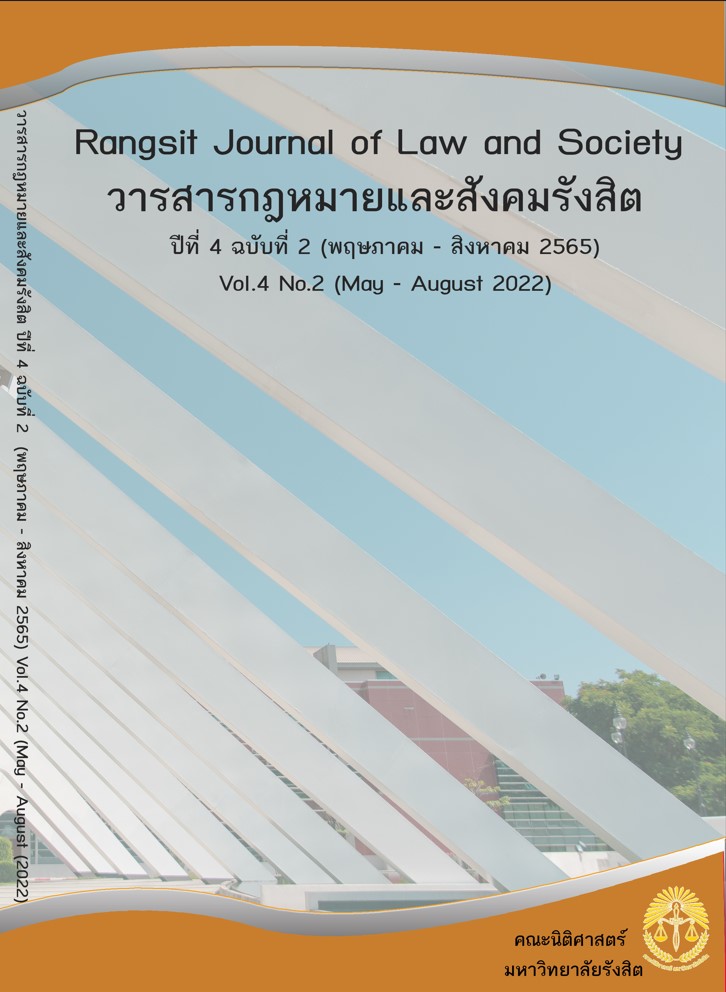การแก้ไขพฤตินิสัยผู้ต้องขังด้วยเทคโนโลยีดิจิทัลในช่วงเวลา ที่อยู่ในเรือนนอน
Main Article Content
บทคัดย่อ
วัตถุประสงค์ของการบังคับโทษจำคุกมีเป้าหมายหลักเพื่อให้ผู้ต้องโทษสามารถดำรงชีวิตในอนาคตได้ใหม่อีกครั้งโดยปราศจากการกระทำความผิดและมีความรับผิดชอบต่อสังคม นอกเหนือจากการลงโทษจำคุกเพื่อเป็นการแก้แค้นทดแทน ข่มขู่ ตัดโอกาสการกระทำความผิด ที่เป็นวัตถุประสงค์ของการลงโทษที่มีอยู่เดิม นอกจากนั้นการแก้ไขพฤติกรรมของผู้กระทำความผิดก็เป็นตัวชี้วัดหลักของการบรรลุผลสัมฤทธิ์ของการลงโทษจำคุก กล่าวคือ ต้องยกระดับที่สามารถเปลี่ยนความคิดจิตใจและพฤติกรรม ของผู้ต้องโทษให้ได้ภายในระยะเวลาที่ต้องโทษ ทั้งนี้เพื่อคืนคนดีสู่สังคม และหยุดการกระทำความผิดซ้ำของเขาเหล่านั้นเป็นสำคัญ ข้อมูลจากการศึกษาวิจัยอย่างต่อเนื่องมาในประเทศไทยพบว่าการใช้เวลาในเรือนจำ 1 วัน มี 24 ชั่วโมง มักกำหนดให้ผู้ต้องโทษจำคุกต้องถูกจำกัดอยู่ในเรือนนอนเป็นระยะเวลาที่ค่อนข้างมาก จึงมีเวลาที่ออกมาสู่ภายนอกที่น้อยกว่า กิจกรรมการแก้ไขพฤตินิสัยจึงทำได้ไม่มากนักและภายในเวลาจำกัด ซึ่งหากพิเคราะห์ระยะเวลาในการที่ผู้ต้องโทษต้องอยู่ในเรือนนอน พบว่าเวลานอนจริงๆ ของบุคคลตามหลักวิชาการทางวิทยาศาสตร์ประมาณ 7-8 ชั่วโมง จึงยังมีช่วงเวลาก่อนนอนจริงเหลืออยู่อีกหลายชั่วโมง ซึ่งตามข้อเท็จจริงเมื่อผู้ต้องโทษขึ้นเรือนนอนแล้วก็จะทำกิจกรรมอะไรไม่ได้มาก แต่เขาเหล่านั้นต้องมาอยู่รวมกันในที่จำกัดซึ่งอาจก่อให้เกิดความขัดแย้ง วิวาทกัน การพูดคุยแลกเปลี่ยนเรียนรู้กันได้ในเรื่องที่ไม่พึงประสงค์ แอบสักตามเนื้อตัวร่างกาย หรือมีกิจกรรมอื่นที่ไม่พึงประสงค์ ในช่วงเวลาดังกล่าวนี้ ทั้งที่เวลาดังกล่าวสามารถนำมาใช้ประโยชน์ในการแก้ไขพฤติกรรมได้ โดยการจัดให้มีสื่อดิจิทัลต่างๆ ที่มีเป้าประสงค์ในเชิงตัวชี้วัดด้านจิตใจ ปัญญา พฤติกรรม ของผู้ต้องโทษกลุ่มต่างๆ แต่ละห้องของเรือนนอน
Article Details

อนุญาตภายใต้เงื่อนไข Creative Commons Attribution-NonCommercial-NoDerivatives 4.0 International License.
เอกสารอ้างอิง
ไสว สุทธิพิทักษ์. (2552). การเมืองกับการศึกษา. บันทึกคำบรรยายระดับบัณฑิตศึกษา, 2.
ธานี วรภัทร์. (2558). กฎหมายว่าด้วยการบังคับโทษจำคุก. พิมพ์ครั้งที่ 3. กรุงเทพมหานคร: วิญญูชน.
ธานี วรภัทร์. (2560). ผู้ต้องขังเป็นศูนย์กลาง. วารสารกำลังใจ สำนักกิจการในพระดำริพระเจ้าหลานเธอ พระองค์เจ้าพัชรกิติยาภา, 5(4), 32-37.
Anup Maheshwari. (2019). Digital Transformation. New Jersey, USA: Wiley.
Palmer, et al. (2020). Evaluation of digital Technology in Prisons. London: Ministry of Justice.
Pia Puolakka. (2021, July 6). Towards digitalisation of prisons: Finland’s Smart Prison Project. Retrieved from Penal Reform International (PRI): https://www.penalreform.org/blog/towards-digitalisation-of-prisons-finlands-smart-prison-project/
Sajith Karikkandathi. (2016, October 30). Digital Technology and the Prison of the Future. Retrieved from Microsoft New Center Middle East & Africa: https://news.microsoft.com/en-xm/2016/10/30/digital-technology-and-the-prison-of-the-future/
The Centre for Social Justice. (2021). DIGITAL TECHNOLOGY IN PRISONS Unlocking relationships. learning and skills in UK prisons.

